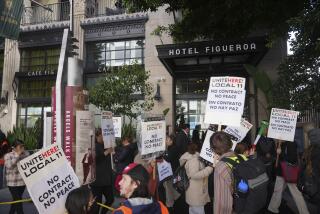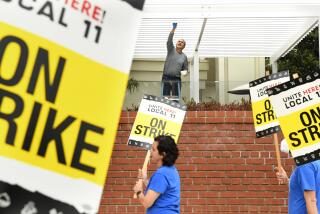Hotel rates near pre-recession prices — and rising
Get ready for hotel rates to rise above pre-recession prices.
In the first week of September, the average room rate in the U.S. rose to $107, just short of the high mark of $110 set in March 2008, according to the latest statistics from Smith Travel Research Global in Tennessee.
In Los Angeles, room rates climbed to an average of $127, short of the $133 peak set in summer 2008, according to Smith Travel Research.
Over the last three years, hotel rates have been a moving target. They dropped for 18 straight months starting in the fall of 2008, pushed down by slumping demand and a faltering economy.
As Americans began to travel again, hotel rates started to climb, beginning in the spring of 2010.
And despite a still-sluggish economy, the growing demand for business and leisure travel is expected to push hotel prices even higher in the months leading up to the holiday season, said Mike Kistner, chief executive of Pegasus Solutions, a Dallas firm that provides reservation technology and marketing for the hotel industry.
“While the hotel industry is strongly influenced by the economy,” he said, “leisure and business travelers don’t take their marching orders from it.”
• Security gate uses iris scans
As of yet, no airport in the U.S. uses biometric techniques — such as voice matching, iris scans or fingerprints — to confirm passengers’ identities. But that may change.
A Silicon Valley high-tech company last week demonstrated an electronic gate at the Norman Y. Mineta San Jose International Airport that scans a passenger’s iris to confirm his or her identity.
The “e-gate” developed by AOptix Technologies Inc. of Campbell has not been approved for use at U.S. airports. Company representatives say the technology is in use on a limited basis at airports in Britain and Qatar and could be ready for deployment throughout the U.S. in about 12 to 18 months.
“We are improving the passenger experience while trying to enhance aviation security,” said Joseph Pritikin, director of product marketing for AOptix.
The biggest drawback to using an iris scan is confirming a passenger’s identity. To do that, a record of the passenger’s iris and ID must be on file. As a result, travelers would have to undergo a scan and submit personal data before going to an airport to catch a flight.
Once airport security officials have your data in a computer system, they could use it to confirm your identity at a checkpoint.
The Transportation Security Administration plans to launch a pilot program this fall to allow frequent fliers who submit personal data to the government to speed through a special security checkpoint. But that program won’t use biometrics.
AOptix’s Pritikin said the e-gate system could work with the TSA program because an iris scan takes two seconds and has a very low error rate.
A TSA spokesman said he couldn’t comment on AOptix’s technology because he had not heard about it.
David Vossbrink, communications director for the San Jose airport, said: “Obviously there is some potential for this technology to be used in the security arena.”
FOR THE RECORD:
A previous version of this article incorrectly referred to David Vossbrink as David Hossbrink.
• How to get kicked off a plane
After Southwest Airlines booted actress Leisha Hailey off a plane last week after she smooched with another woman, the founder of the travel website Airfarewatchdog pointed out that each airline has a list of behaviors that will get you escorted back to the terminal.
George Hobica noted that Delta Air Lines, for example, has a list of 13 passenger no-nos.
Among the behaviors that will get people tossed from a Delta flight: being disorderly, abusive or violent; interfering with a flight crew; flying barefoot; flying drunk; and flying with a “malodorous condition.”
Hobica said Delta also has a “somewhat vague” rule about passenger conduct that prohibits fliers from creating an unreasonable risk of offense or annoyance to other passengers. He adds: “No word if it includes two women kissing.”
More to Read
Inside the business of entertainment
The Wide Shot brings you news, analysis and insights on everything from streaming wars to production — and what it all means for the future.
You may occasionally receive promotional content from the Los Angeles Times.










